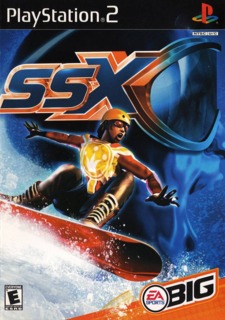Beautiful graphics, polished gameplay, and plenty of challenge make SSX an instant classic that nearly anyone can enjoy.
I actually remember my thought process as I decided to purchase SSX. On one hand, I had played snowboarding games before, on the original Playstation, and found them to be not to my liking. On the other hand, being a skier, I wanted a skiing game, and SSX, though featuring athletes from the “dark side,” was the closest I was going to get. And besides, the graphics were absolutely gorgeous. So I took the plunge.
What I discovered was a game replete with challenge, depth, variety, and, most importantly of all, fun. Where most previous snowboarding games had attempted to accurately translate the sport that treats us every winter during the X-Games, SSX took the concept in a direction that can be best defined as “cartoonish.” Instead of a world where a FS 900 is a top-end trick, SSX practically set that as the lower limit to what you’d do off of a jump.
Riders in SSX spin and twirl through the air in manners that would make real riders lose their lunches. Courses are steeper, faster, more treacherous, and longer than anything you’d find in real life. And all of this is presented in graphics that simply boggle the mind when it comes to quality. Your rider is controlled by a surprisingly easy-to-learn control scheme, even if you switch it to the much-suggested “advanced” mode. Board grabs are done with the shoulder buttons. Jumping is done with X. Control falls to the analog sticks and D-pad. It takes practically no time to be able to hurtle down a course with reckless abandon, and it even feels like you’re carving along a sharp metal edge on the side of an icy cliff face.
However, even though the game is easy to learn, it takes quite the effort to master. Simply making your way down some of the more advanced tracks can be quite a challenge. That challenge is magnified by the two types of events that are featured in the game: Race events and Showoff events.
Race events are exactly what they sound like: A race to the bottom of the course, by any route that you can find. Shortcuts and hidden paths abound in the game, though not all of them necessarily provide a faster time. Additionally, successfully landing tricks will provide you with a usable adrenaline boost that increases you speed. This results in race events that force the player to not only find the best path, but also perform tricks to get the much-needed boost. Sometimes, the races can be extremely frustrating, but there is a definite sense of reward when you finally put together a stellar run to take home a gold medal.
Showoff events are of a completely different nature. Instead of directly competing against opponents, you are given point goals. Here, while the boost accumulated by tricks is important in that it can help you hit bigger jumps, the focus of your competition is landing tricks for points. This is made even more challenging by the existence of point multiplier icons that appear during Showoff events, encouraging you to snag them in order to really rack up the numbers. Some of the point goals for a gold medal in Showoff mode seem nearly unreachable at first, but with experience and practice, they become doable.
If there is one complaint about the game modes, it’s in the tracks themselves. While the tracks are incredibly unique, ranging from a desert to a pinball machine to a melting iceberg, some are most definitely “race” tracks while others are “trick” tracks. This can make some of the Race or Showoff events on an opposite style track frustrating at best.
Besides the normal medal competition, the game also features a variety of unlockables that players can obtain. Four additional characters can be unlocked through play, each with their own strengths and weaknesses. Each character also has a variety of boards that boost certain attributes, and outfits to make the character look the way you’d like them to look. While there are some rough edges in the distribution of character attribute points, overall, it’s easy to overlook those gaffs in light of the complete package that is presented.
The presentation of the game is also superb, with a clean, consistent look on the head-up display that never intrudes on the gameplay. The game also features a live DJ that reacts to the action on the screen with comments and quips, and an excellent soundtrack that matches up to the frenetic action well. The soundtrack is probably one of the biggest non-gameplay highlights of the game, as the game will dynamically drop sections of the music during events, such as flying through mid air for a trick, to highlight the action on screen.
Overall, SSX provides a solid package that is nearly unmatched when it comes to PS2 launch games. The game’s graphics and presentation are spectacular, and the gameplay is balanced for both challenge and fun. Even those with a casual interest in dodging trees, pulling big air, and breakneck dashes to finish lines will enjoy SSX. It’s a gaming masterpiece that would be a shame to pass up.

